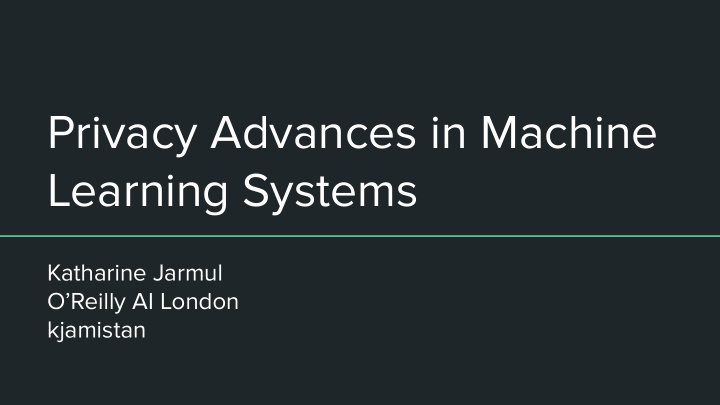



Privacy Advances in Machine Learning Systems Katharine Jarmul O’Reilly AI London kjamistan
When did consumers become concerned about privacy and computing?
From Understanding Privacy Concerns (1992) A 1990 Louis Harris survey commissioned by Equifax, for instance, found 71 percent of the respondents believed consumers "have lost all control over how personal information about them is used by companies"). More recently, a 1991 Gallup survey found 78 percent of the respondents described themselves as "very concerned" or "somewhat concerned" about what marketers know about them. Nowak et al., 1992.
How and when were people *actually* affected by privacy-unaware data collection?
Privacy Issues in Knowledge Discovery and Data Mining (2000) Despite collecting over $16 million USD by selling the driver-license data from 19.5 million Californian residents, the Department of Motor Vehicles in California revised its data selling policy after Robert Brado used their services to obtain the address of actress Rebecca Schaeffer and later killed her in her apartment. Brankovic et al., 2000.
What do machine learning and cryptography have in common?
From Cryptography and Machine Learning (1988) Machine learning and cryptanalysis can be viewed as “sister fields,” since they share many of the same notions and concerns. In a typical cryptanalytic situation, the cryptanalyst wishes to "break" some cryptosystem. Typically this means he wishes to find the secret key used by the users of the cryptosystem, where the general system is already known. The decryption function thus comes from a known family of such functions (indexed by the key), and the goal of the cryptanalyst is to exactly identify which such function is being used. This problem can also be described as the problem of "learning an unknown function" (that is, the decryption function) from examples of its input/output behavior and prior knowledge about the class of possible functions. Rivest, 1988.
Privacy in ML
Defining the Problem
Threat Model: - Exposing - Private Data Private Data via Collection & Queries or Storage? Model Access? - Sharing - Private Private Data Predictions? for Training?
Notable Past Work
Timeline 1978 - Concept of Homomorphic Encryption 1982 - Data Swapping 1998 - K-Anonymity 2003 - Tor Project Publicly Released 2005 - Personal Search Results (Google) 2006 - Differential Privacy 2009 - Differentially Private Logistic Regression 2010 - Full Homomorphic Encryption
Homomorphic Encryption Partially Homomorphic (PHE) - Additive or multiplicative Somewhat Homomorphic (SWHE) - Addition and multiplication, but limited # of ops Fully Homomorphic (FHE) - Addition, multiplication for unbound # of ops
Distributed Clustering Merugu et al., 2005.
Recent Advances in Privacy-Preserving Machine Learning
Federated Learning TensorFlow Federated enables developers to express and simulate federated learning systems. Pictured here, each phone trains the model locally (A). Their updates are aggregated (B) to form an improved shared model (C). Google: tf-federated
Encrypted Learning: Secure Multiparty Computation DropoutLabs: tf-encrypted
Differential Privacy Abadi et al., 2015.
Adversarial Regularization Nasr et al., 2018.
Encrypted Prediction Queries Bost et al., 2015.
Still Unanswered Questions
Overfitting? Model Capacity? Poor Regularization? Zhang et al., 2017
Accurate, Practical Threat Modeling Image: https://www.pivotpointsecurity.com
Privacy & Interpretability Shokri et al., 2019
Accurate Definitions of Privacy Privacy is not about control over data nor is it a property of data. It's about a collective understanding of a social situation's boundaries and knowing how to operate within them. In other words, it’s about having control over a situation. It's about understanding the audience and knowing how far information will flow. It’s about trusting the people, the situating, and the context. -- danah boyd
Location Tracking and Privacy Policies (2008) The work presented in this article confirms that people are generally apprehensive about the privacy implications associated with location tracking . It also shows that privacy preferences tend to be complex and depend on a variety of contextual attributes (e.g. relationship with requester, time of the day, where they are located). Through a series of user studies, we have found that most users are not good at articulating these preferences. Sahdeh et al., 2008.
The scientist and engineer has responsibilities that transcend his immediate situation, that in fact extend directly to future generations… We are all their trustees. Joseph Weizenbaum, 1976
Thank you! Questions? - Now? - Later? - katharine@kjamistan.com - @kjam (Twitter)
Slide References Nowak et al., Understanding Privacy Concerns , 1992. ● ● Brankovic et al., Privacy Issues in Knowledge Discovery and Data Mining , 2000. ● Rivest, Cryptography and Machine Learning , 1988. ● Merugu et al., A privacy-sensitive approach to distributed clustering, 2004 . Tf-federated: https://www.tensorflow.org/federated ● ● Tf-encrypted: https://github.com/tf-encrypted/tf-encrypted ● Abadi et al., Deep Learning with Differential Privacy , 2015 ● Bost et al., Machine Learning Classification over Encrypted Data , 2015. Zhang et al., Understanding Deep Learning Requires Rethinking Generalization , 2017. ● ● Shokri et al., Privacy Risks of Explaining Machine Learning Models , 2019. ● Sadeh et al., Understanding and Capturing People’s Privacy Policies in a Mobile Social Networking Application , 2008. ● Brankovic et al.,, Privacy Issues in Knowledge Discovery and Data Mining , 2000. NYTimes Privacy Policy Investigation: ● https://www.nytimes.com/interactive/2019/06/12/opinion/facebook-google-privacy-policies.html ● Weizenbaum, Computer Power and Human Reason , 1976.
Recommend
More recommend